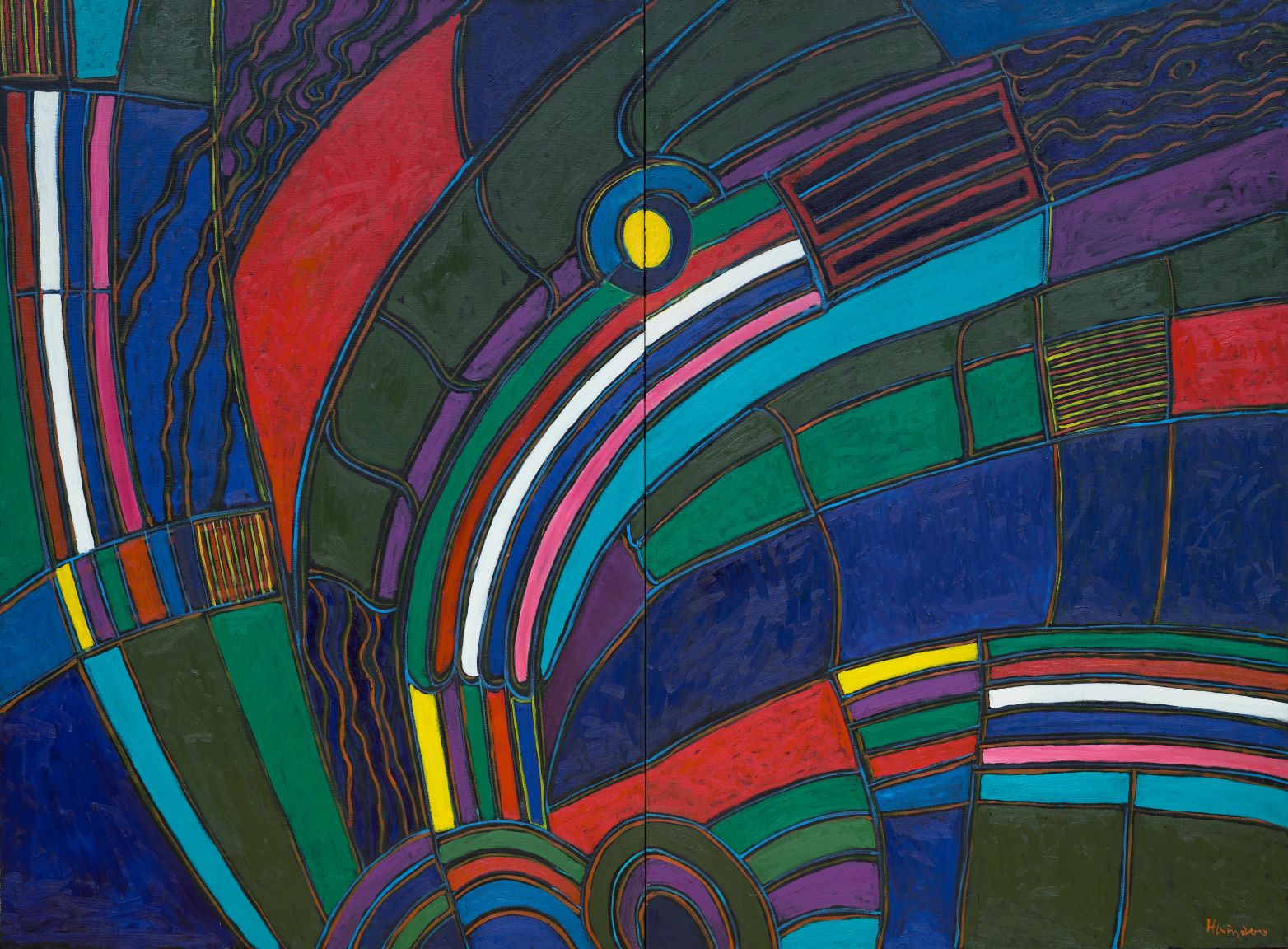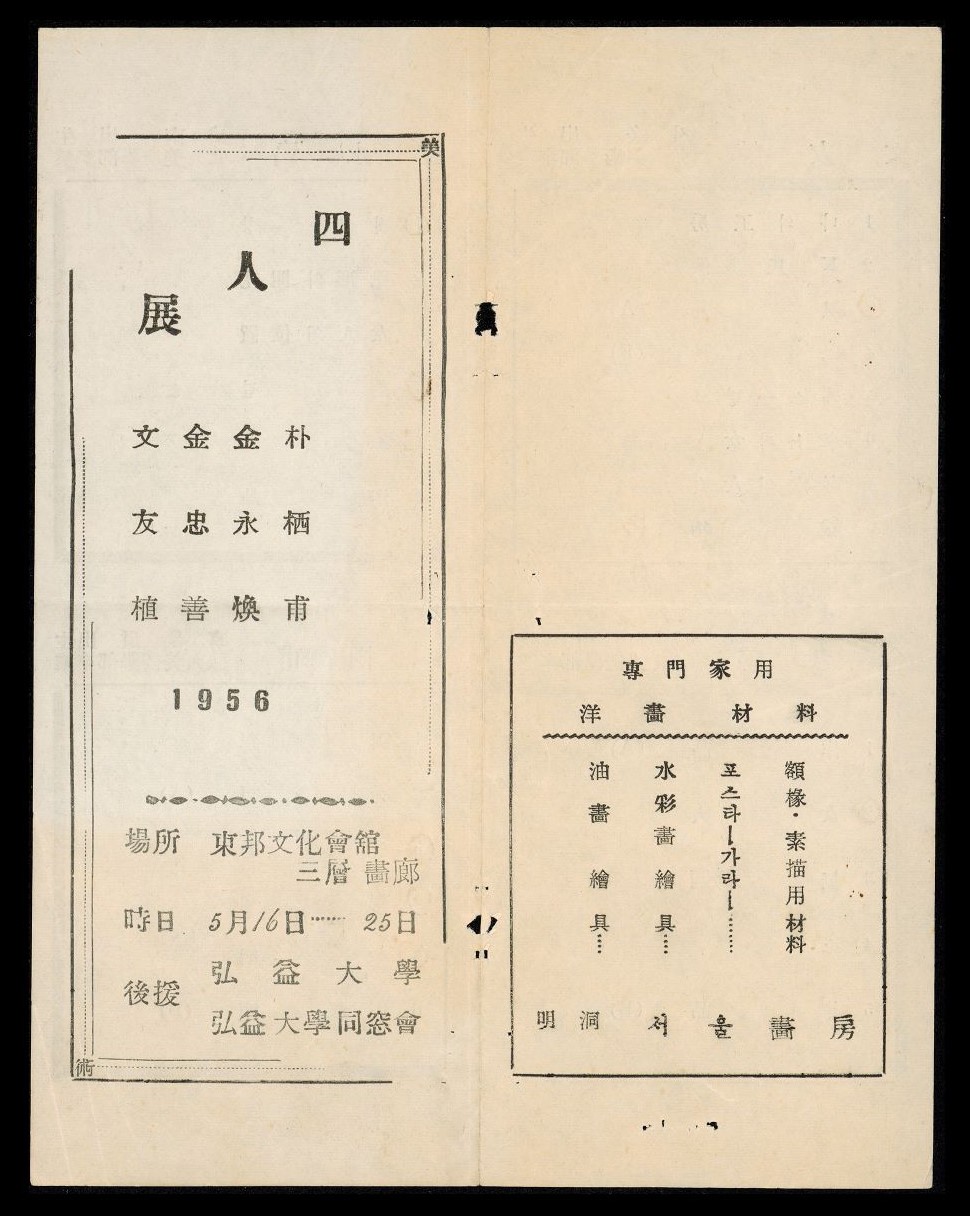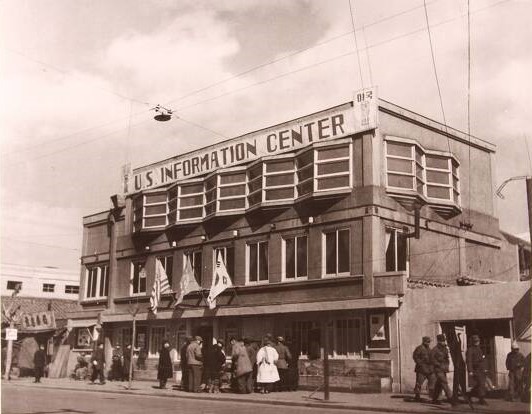
The Second Exhibition of Hyundae Fine Artists Association Leaflet, 1957. MMCA Art Research Center Collection
Hyundae Fine Artists Association
* Source: Multilingual Glossary of Korean Art. Korea Arts Management Service
Related
-

1960 Fine Artists Association
A group comprised of 12 alumni from Seoul National University and Hongik University. The group was active from 1960 to 1961. Its members opposed the National Art Exhibition (Gukjeon) and rejected the artistic traditions established during the Japanese colonial period, and sought to pursue an avant-garde style of art. In 1961, the group disbanded after holding two exhibitions in collaboration with the Hyundae Fine Artists Association, and several members went on to establish the Actuel collective. The group is noteworthy for its popularization of Art Informel within the art community of Korea.
-

Ha Indoo
Ha Indoo (1930-1989, pen name Cheonghwa) was a leading Korean abstract painter who helped found the Hyundae Fine Artists Association [Hyeondae misulga hyeophoe]. Ha graduated from the College of Fine Arts at the Seoul National University in 1954. He was one of the first generation of artists to graduate from art school after the liberation of Korea and was a founding member of the Hyundae Fine Artists Association in 1957, where he led the Art Informel movement alongside Kim Tschang-yeul and Park Seo-Bo. In the 1960s, Ha Indoo embraced Op art that was introduced to Korea and moved to geometric color field abstraction, introducing Eastern Buddhist ideas into his work, and in the 1970s, he created a series of works such as Mandala, Dynamic Circle, and Stable Point in a Dynamic Circle. In the late 1980s, he created the series Fire of Soul–Cyclone of Light, expressing the irreverence for life and worship of the gods that he had experienced during his battle with cancer, with dynamic light in bright colors such as yellow, orange, red, and purple. He became a Cheondogyo believer in the 1960s, but later converted to Buddhism and Christianity. Throughout his life, he developed a body of work with religious connotations, inspired by Buddhist mandalas and Christian stained glass. By exploring archetypes of traditional Korean culture through Buddhist paintings, decorative coloring (dancheong), and folk paintings, he developed his own style of abstraction that embodies religious thought and intention.
-

Actuel
A group of artists that formed when the Hyundae Fine Artists Association merged with the 1960 Fine Artists Association after a joint exhibition in 1961. The group comprised several young artists in their twenties and thirties who pursued avant-garde art, and adopted Informel as a common ideology for Korean contemporary art. Actuel was highly influential in the Daehan Art Association, and it received criticism for selecting three of its own members to participate in the Paris Biennale. The group disbanded after its second exhibition in April 1964.
Find More
-

Park Seo-Bo
Park Seo-Bo(1931-2023, real name Park Jaehong) belongs to the first generation of artists who received art education in Korea after Korea’s liberation from Japan. He was a leading figure in Art Informel and Dansaekhwa. He was born in Yecheon, Gyeongsangbuk-do Province. He majored in Western painting in the College of Fine arts at Hongik University and graduated in 1955. He served as a professor at Hongik University and the board president of the Korean Fine Arts Association (Hanguk misul hyeophoe). Park made his debut as a painter in 1956 through the Four Artists Exhibition that declared resistance to the National Art Exhibition and the established generation. After presenting abstract expressionist work completely different from the established art at the third Hyundae Fine Artists Association exhibition in 1958, he led the Art Informel movement until the mid-1960s. In the 1970s, he headed large-scale special exhibitions, including Independants, the Seoul Contemporary Art Festival, Ecole de Séoul, and Korea: Facet of Contemporary Art. He also played a key role in establishing “Dansaekhwa” as a style of Korean painting in the 1970s. His oeuvre can be divided into three periods. The first period (late 1950s–mid 1960s) is referred to as the Art Informel period, during which Park depicted the post-war situation with distorted and deconstructed human forms, dark colors, and rough matière, particularly in the Primordials series. During the second period (late 1960s–early 1970s), he focused on the modernization of tradition, presenting optical and geometric abstraction with five colors representing the five cardinal directions as the dominant compositional element under the thesis of hereditarus. During the third period (1970s–2023), which is known as the period of monochrome painting, he presented the Ecriture series, in which performance was fundamental to his creation. The Ecriture series can be divided into two periods: before and after year 1982. In the former period, Park repeatedly applied milky oil paint to a canvas and before it dried, drew lines with a pencil or a tool with a sharp tip, thus leaving traces of this act on the canvas. In the latter period, he used water-based paints instead of oil-based paints in an effort to more directly capture his emotions with bright hues inspired by the colors of nature. Until his death, he sought to build the identity of Korean art through various methodologies within a single thesis of ecriture and elevated Dansaekhwa to an international level.
-

Four Artists Exhibition
An exhibition held at the Eastern Cultural Center from May 16 to May 25, 1956. The featured artists—Kim Younghwan, Kim Chungsun, Moon Woosik, and Park Seo-Bo—were alumni of Hongik University. Together protesting in front of the show itself, they declared their opposition to the National Art Exhibition (Gukjeon). The Korean art community of the day, which centered around the National Art Exhibition, imitated the manner of Japanese Academicism, and their declaration was the result of these younger artists’ resistance to this practice. They opposed the realist focus espoused within the National Art Exhibition and influenced the founding of the Modern Art Association, the Hyundae Fine Artists Association, the Creative Art Association [Changjak misul hyeopoe], Sinjohyeongpa, and the Paek Yang Painting Association.
-

United States Information Service
An organization under the United States Information Agency that was responsible for the overseas promotion of the policy and culture of the USA. In Korea, the service established its headquarters at Bando Hotel in 1948, and regional branches in major cities such as Busan, Cheongju, Jeonju, Gwangju, Daegu, and Jeju City. The service’s operations included English education, media screenings, publishing, and exhibitions. During the 1950s, when the United States began to harness the potential of culture in relation to Cold War politics, the service supported exhibitions such as the Eight American Artists and the Family of Man exhibition. The service greatly influenced the Korean art community during the period of military rule until 1987, which had little other opportunity for exposure to overseas art.






